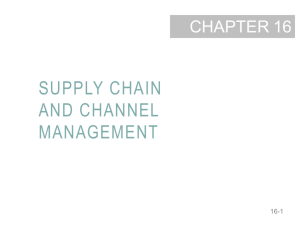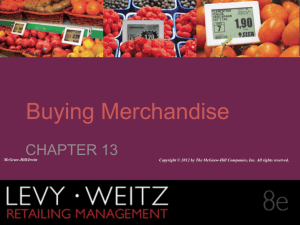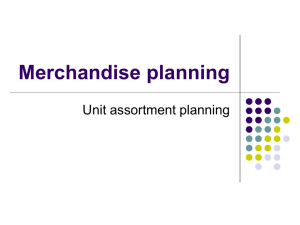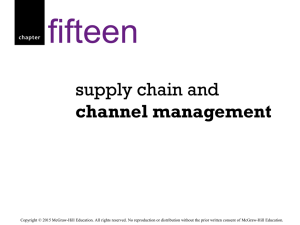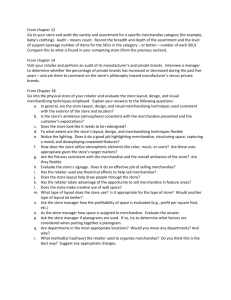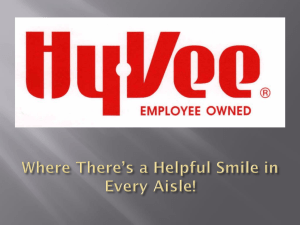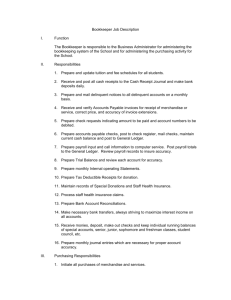Business & Marketing Terms Review: KOSSA
advertisement
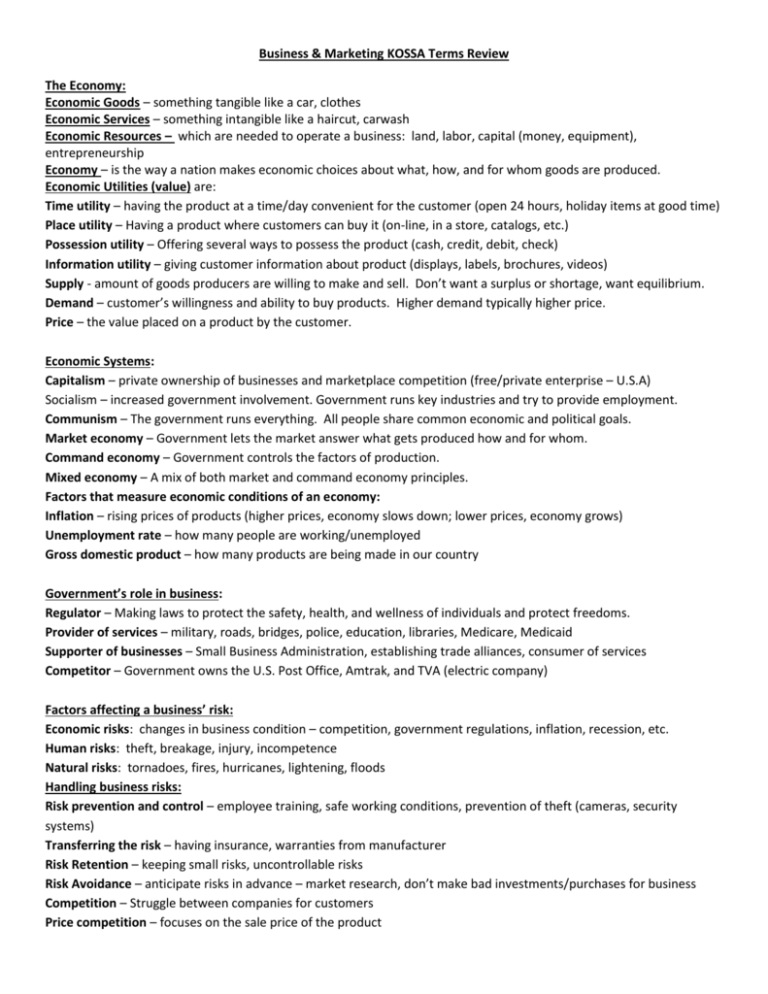
Business & Marketing KOSSA Terms Review The Economy: Economic Goods – something tangible like a car, clothes Economic Services – something intangible like a haircut, carwash Economic Resources – which are needed to operate a business: land, labor, capital (money, equipment), entrepreneurship Economy – is the way a nation makes economic choices about what, how, and for whom goods are produced. Economic Utilities (value) are: Time utility – having the product at a time/day convenient for the customer (open 24 hours, holiday items at good time) Place utility – Having a product where customers can buy it (on-line, in a store, catalogs, etc.) Possession utility – Offering several ways to possess the product (cash, credit, debit, check) Information utility – giving customer information about product (displays, labels, brochures, videos) Supply - amount of goods producers are willing to make and sell. Don’t want a surplus or shortage, want equilibrium. Demand – customer’s willingness and ability to buy products. Higher demand typically higher price. Price – the value placed on a product by the customer. Economic Systems: Capitalism – private ownership of businesses and marketplace competition (free/private enterprise – U.S.A) Socialism – increased government involvement. Government runs key industries and try to provide employment. Communism – The government runs everything. All people share common economic and political goals. Market economy – Government lets the market answer what gets produced how and for whom. Command economy – Government controls the factors of production. Mixed economy – A mix of both market and command economy principles. Factors that measure economic conditions of an economy: Inflation – rising prices of products (higher prices, economy slows down; lower prices, economy grows) Unemployment rate – how many people are working/unemployed Gross domestic product – how many products are being made in our country Government’s role in business: Regulator – Making laws to protect the safety, health, and wellness of individuals and protect freedoms. Provider of services – military, roads, bridges, police, education, libraries, Medicare, Medicaid Supporter of businesses – Small Business Administration, establishing trade alliances, consumer of services Competitor – Government owns the U.S. Post Office, Amtrak, and TVA (electric company) Factors affecting a business’ risk: Economic risks: changes in business condition – competition, government regulations, inflation, recession, etc. Human risks: theft, breakage, injury, incompetence Natural risks: tornadoes, fires, hurricanes, lightening, floods Handling business risks: Risk prevention and control – employee training, safe working conditions, prevention of theft (cameras, security systems) Transferring the risk – having insurance, warranties from manufacturer Risk Retention – keeping small risks, uncontrollable risks Risk Avoidance – anticipate risks in advance – market research, don’t make bad investments/purchases for business Competition – Struggle between companies for customers Price competition – focuses on the sale price of the product Non-price competition – focuses on product quality, services, reputation, location, expertise, ect. Productivity – Output per work hour measured over a period of time (how productive are employees?) Social Responsibility of business in society – doing good things for your community through your business Environmental issues: Recycling, not polluting the environment, conservation, ozone-safe, environmentally friendly Ethical issues: guidelines for good behavior. Doing the right thing in business for the well-being of everyone. Community involvement: Being involved in the community – Donating money/time to charities, other organizations. Different types of business activities: Market research – methods used to gather information, analyze it, and report to make business decisions Financial analysis – being able to analyze a business’s financial statements. Marketing – the process of developing, promoting, and distributing products to satisfy customers wants and needs. Human resources – the process of choosing employees, retirement options, employee benefits Explain the process of purchasing: Information gathering: Open- to-buy: Amount of money left for buying goods after all purchase received and on-orders have been considered. Selecting suppliers : based on production capabilities, past experiences with them, special services and buying services Buying methods: Resident buying: retailer’s representatives in a central market give information to them about closeouts, special buys in the market, merchandise offerings. Centralized buying – Buying for all branches in a chain is done in a central location. Decentralized buying – local store managers or designated buyers can make special purchases for their stores. Net Sales = Gross sales of a company – sales returns and allowances (Example: $23,000 = $25,000 – $2,000) Role of Management: Planning: Deciding what will be done and how it will be accomplished. Organizing: A coordinated effort to reach a company’s planning goals – assigning, staffing and directing employees. Controlling: the process of comparing what you planned with actual performance – setting standards, evaluating performance, and solving problems. Types of Business Records: Income statement: A summary of a business’s income and expenses during a period of time – shows if profit or loss. Balance sheet: A summary of a business’s assets (building, cash, equipment) liabilities (debts – money owed) = owner’s equity (new worth – what is the business worth) Sales records: Files of customer purchases with addresses, amounts, dates, products, payment methods, returns and other information constitute a rich trove of marketing data. Employment records: Examples are: Any application for employment; Wage or salary history; Notices of commendation, warning, discipline, or termination; Authorizations for a deduction or withholding of pay; Fringe benefit information; Leave records; and Employment history with the employer, including salary and compensation history, job titles, dates of promotions, transfers, and other changes, attendance records, performance evaluations, and retirement record. New employee orientation procedures: A. Introduction: Introduce employee to co‐workers and other unit managers. B. Tour of Work Location C. Discuss work schedule D. Time and Attendance (schedule) E. Explain how the department, co‐workers and employee contribute to the mission of the business. F. Duties/Performance/Evaluation. G. Employee Development - Explain how the employee will be trained. H. Safety Procedures Explain the safety procedures that are applicable to the Types of business ownership: Sole proprietorship – only one owner, most liability (risk) Partnership – two or more people responsible for a business (someone to share risk and decision-making) Corporation – a business that is chartered by a state and legally operates apart from the owner or owners (sells stock) Channels of Distribution: Direct channels – no intermediaries, from the manufacturer/producer to customer (farmer sell directly to customer) Indirect channels – using intermediaries to get product from manufacturer to customer such as wholesaler, retailer, etc. Manufacturer (TTAI) – makes the product Wholesaler (Modern Vending) – buys from the manufacturer, stores the product, resells product to the retailer Retailer (Wal-Mart) – sells product to the customer Distribution intensity: Exclusive distribution – protected territories for distribution of a product in a given geographic area only so many McDonalds allowed in an area. Selective distribution – a limited number of outlets in a geographic area can sell the product. Want to maintain an image. Selling Ralph Lauren products only in higher-end stores. Intensive distribution – involves the use of all suitable outlets to sell a product. Selling toilet paper in all stores that sell it. Invoices/Receiving Process Invoices – are bills for items that your business has received. Invoices include the company’s name, current date, items received, cost of items, total amount owed with tax. 1. Receiving merchandise – usually merchandise received in the back area/side area of the building. A receiving record explains what merchandise is received, name of the shipper, number of items delivered, shipping charges, etc. 2. Checking merchandise – Checking the quantity and condition of merchandise that was received 3. Marking merchandise – marking merchandise with selling price/ other information. Most common method – UPC code. Transportation systems most commonly used by businesses to transport merchandise: Trucks – most common Planes – most expensive, fastest Ships – slower but relatively inexpensive Railroad – reliable, hauls large items UPS, Fed Ex – are express carriers Storage of merchandise: Commodity storage – used primarily to store commodities : agricultural products such as tobacco, cotton, or grain Bulk storage – store products only in bulk form, such as chemicals and oil Cold storage – Used more for perishable items such as fruits, vegetables, and frozen products Types of Warehousing: Distribution centers – a warehouse designed to speed delivery of goods and minimize storage costs – Wal-Mart Distribution center (they keep products at centrally located distribution centers so Wal-Mart stores get quicker Public warehouses – offers storage and handling facilities to individuals or companies. Available to anyone who will pay for its use. Private warehouses – a facility designed to meet the specific needs of its owner. Company owns private warehouse. Marketing Research/Marketing Information Marketing Information – information that can be used to help a business make better decisions about products to carry, prices to charge, promotions to use, etc. Ways to obtain data for market research is: Surveys – asking questions to determine data a company wants to find out about Interviews – personal interview, telephone interview, focus group, mall survey Observations – Mystery shoppers, one-way mirrors, hidden camera, traffic counts, point-of-sale research Target markets/Market Segmentation Demographics – statistics that describe a population in personal characteristics such as age, gender, income, ethnic background, education and occupation. Psychographics – based on consumers social and psychological characteristics such as: people who like sports, photography, cooking, etc. Businesses target people with different interests. Geographics – based on where people live. Locally, regional, national, or globally. Example: People in Florida don’t need snow skis. Factors that affect pricing decisions of a business: 1. How much the product cost the business. 2. What the competition has and is charging for their products. 3. Economic factors such as inflation, taxes, supply and demand, etc. Product development Product Mix – All of the different products that a company makes and sells. It is based on the image of the business, the wants of the market, and objectives of the company. Ways to position a company’s products (to make different from competitors) a. features and benefits – Rockport shoes positioned as comfortable shoes b. price/quality – having different prices based on the quality; Ford Focus – economical compact, Ford Taurus as fullsize passenger, etc. c. competition – creating an image that your product is superior to the competition Branding of products: Branding – is a name, term, design, or symbol used to identify a business or organization Nike – brand, swoosh – trademark, Just Do It – slogan (all parts of branding) Warranties/Guarantees offered on products: Warranties – A promise or guarantee given to a customer that a product will meet certain standards. Guarantees – Used for promotional phrases such as “money-back guarantee”, “results guaranteed” Consumer Protection Agencies: a. Federal Trade Commission – investigate deceptive and misleading business practices, like false advertising. Prohibits unfair competition. b. Better Business Bureau – The BBB also alerts the public to scams, reviews advertising, and assists when donating to charity, also gives free business reliability reviews. c. Consumer Product Safety Commission – monitors the safety of products on the market: They do recalls of unsafe products. Role of Promotion: Promotion’s role is to persuade, inform, or remind people about a company’s products. * Be able to identify the advantages/disadvantages of each type of advertising. The promotional mix is made up of components of each of the following: Advertising – any paid form of media such as radio, TV, billboards, direct mail, outdoor, etc. Sales Promotion – short term incentives to stimulate customers to buy (coupons, rebates, contests). Public relations/publicity – activities designed to create a favorable image toward a business or its products. Personal selling – direct contact between a salesperson and a customer to sell a product. Parts of a print advertisement are: Headline – catches the reader’s attention (short saying) Copy – information about the product/service, event (smaller print) Illustration – picture that goes along with the product/service Price – selling price of product Signature – name, address, phone number, logo, etc. of company Roles of financing Businesses may try to obtain capital from a bank, loan agency, etc. to buy/expand their business. A business may offer their customers store credit cards to pay for their purchases. Math Skills needed in a business environment Business calculations : Mark-ups - are the difference between the price of an item and its cost. Example: Jeans cost $45 – $20 cost = $25 markup Markdown – marking down merchandise (usually by a %). Discounts – reduction in the price of a good or service sold to customers. Employee discounts, cash discounts, quantity discounts Sales calculations: Sales tax – a fee placed on the sale of good and services (local and state sales tax – 6% in Kentucky) Extensions – the result of multiplying the number of units by the cost per unit. 5 computers X $500 = $2,500 (extension) Exchanges – merchandise brought back to be exchanged for other merchandise Allowance - a partial return of the sales price typically because of a defect in the product. Technology items involved in business Word processing skills – use Microsoft Word to type documents such as letters, business plans, resumes Presentation skills – Using Power Point as visual aids to do business presentations Database Skills – use Microsoft Access to put data into database for storage Basic Spreadsheet Skills – Use Microsoft Excel spreadsheets to record data and do charts, graphs, calculations, etc. Search Engines – Google, MSN, etc. are used to locate web sites.
